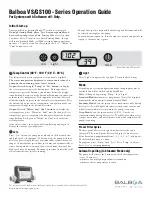
9
WSHP-PRC004-EN
Features and
Benefits
Coaxial Coil
The unit’s internal heat exchanging
water coil is engineered for maximum
heat transfer.
The copper or cupro-nickel seamless
tubing is a tube within a tube design.
The inner-tube contains a deep fluted
curve to enhance heat transfer and
minimize fouling and scaling. Coaxial
heat exchangers are more tolerant to
freeze rupture.
Compressor and Coaxial Coil Isolation
Vibration isolation for the compressor
and coaxial water coil is accomplished
by increasing the rigidity and stiffness at
the base for the compressor, and at the
back of the chassis for the coaxial water
coil. This platform includes double
isolation to the compressor and single
isolation to the coaxial water coil.
Water Connections
The water-in/water-out connections to
the coaxial water coil are located in the
right-hand or left hand end pocket
(option specific).
The water-in/water-out tubes are a
5
/
8
-inch [14.7 mm] OD sweat connection.
The connection is available in either a
left hand or right hand piping end
pocket.
Figure FB-10 – Coaxial Water Coil
Figure FB-11 – Water Connection
Expansion Valve
All Trane water-source systems include
an expansion valve flow metering
device.
This thermal expansion valve (TXV)
allows the unit to operate with an
entering fluid temperature from 25 F to
110 F [-3.9 C to 43.3 C], and entering air
temperatures from 40 F to 90 F [4.4 C to
32.2 C]. The valve precisely meters
refrigerant flow through the circuitry to
achieve desired heating or cooling.
Unlike cap-tube assemblies, the
expansion valve device allows the exact
amount of refrigerant required to meet
the coil load demands. This precise
metering by the TXV increases the
efficiency of the unit.
Reversing Valve
A system reversing valve (4-way valve)
is included with all heating/ cooling
units. This valve is piped to be energized
in the cooling mode. Once the valve is
energized for cooling, it will remain
energized until the control system is
turned to the OFF position, or a heating
cycle is initiated.
Units with the cooling only option will
not receive a reversing valve.
Figure FB-12 – Expansion Valve
Figure FB-13 – Reversing Valve
Blower Housing
The blower housing is constructed of
non-corrosive galvanized steel.
Serviceability to the housing is made
through the chassis air-side front panel.
The fan housing is mounted onto a
fanboard assembly which also includes
the fan wheel, and fan motor. This fan
board assembly may be easily removed
from the chassis by sliding the fan board
frontward in maintenance or service
situations.
Figure FB-14 – Fan Board Assembly










































